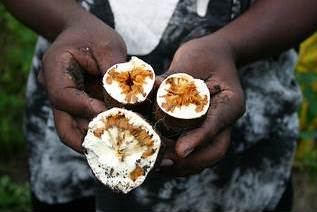A threat from the East: Deadly cassava disease stalking pristine West Africa
- Wednesday, 08 May 2013 17:41
The deadly cassava brown streak disease (CBSD) is rapidly marching westwards in Africa, leaving massive losses in its wake. Fresh outbreaks and increased spread have been reported in DR Congo and Angola.CBSD could halve production of a crop that means food and income for 300 million Africans. Its potential arrival in Nigeria – the world's leading cassava producer – could result in huge food shortages.
 First identified as early as 1935 in East Africa but little-known until just about a decade ago, CBSD is the most stealthy and dangerous of all cassava viruses. 'Hidden' infection can result in total crop loss without the farmer’s knowledge: the unseen killer 'quietly' consumes cassava tubers underground, with no visible symptoms above ground. Only at harvest time do farmers discover the blighted and inedible cassava tubers which – when cut open – reveal trademark brown blotches of destroyed flesh that give the disease its coloured and tainted name (see picture).
First identified as early as 1935 in East Africa but little-known until just about a decade ago, CBSD is the most stealthy and dangerous of all cassava viruses. 'Hidden' infection can result in total crop loss without the farmer’s knowledge: the unseen killer 'quietly' consumes cassava tubers underground, with no visible symptoms above ground. Only at harvest time do farmers discover the blighted and inedible cassava tubers which – when cut open – reveal trademark brown blotches of destroyed flesh that give the disease its coloured and tainted name (see picture).
Scientists have attributed CBSD's sudden spread to a climate-change-induced population explosion of the whitefly – the pathogen-carrying insect which infects cassava while sucking its sap. In Africa, whitefly populations have grown exponentially in recent years, which scientists link to rising temperatures that create more favourable breeding conditions for the persistent pest.
More details on this development on the IBP portal
Relevant links
- West Africa's counter-measures on CBSD: EXCERPT: [By using molecular tools] "We can ... breed pre-emptively for CBSD even before it gains entry into West Africa, with a good level of certainty, even if not 100 percent,” says Dr Chiedozie Egesi of Nigeria's National Root Crop Research Institute (July 2010)
- GCP's Cassava Research Initative
- Join IBP's cassava community (IBP portal)
- Cassava facts and figures (IBP portal)
